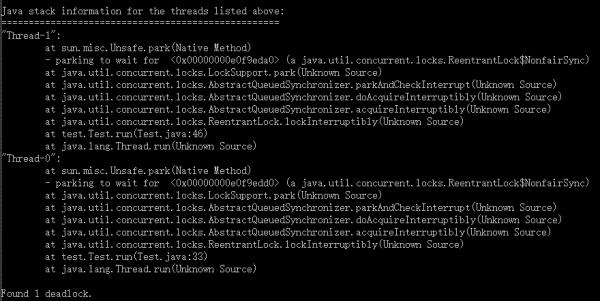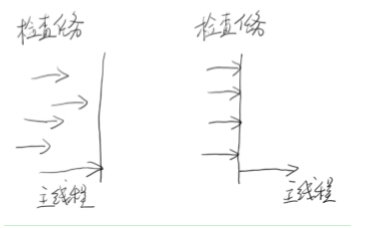java并发包源码怎么读
Posted
tags:
篇首语:本文由小常识网(cha138.com)小编为大家整理,主要介绍了java并发包源码怎么读相关的知识,希望对你有一定的参考价值。
1. 各种同步控制工具的使用
1.1 ReentrantLock
ReentrantLock感觉上是synchronized的增强版,synchronized的特点是使用简单,一切交给JVM去处理,但是功能上是比较薄弱的。在JDK1.5之前,ReentrantLock的性能要好于synchronized,由于对JVM进行了优化,现在的JDK版本中,两者性能是不相上下的。如果是简单的实现,不要刻意去使用ReentrantLock。
相比于synchronized,ReentrantLock在功能上更加丰富,它具有可重入、可中断、可限时、公平锁等特点。
首先我们通过一个例子来说明ReentrantLock最初步的用法:
package test;
import java.util.concurrent.locks.ReentrantLock;public class Test implements Runnable public static ReentrantLock lock = new ReentrantLock(); public static int i = 0;
@Override public void run() for (int j = 0; j < 10000000; j++)
lock.lock(); try
i++;
finally
lock.unlock();
public static void main(String[] args) throws InterruptedException
Test test = new Test();
Thread t1 = new Thread(test);
Thread t2 = new Thread(test);
t1.start();
t2.start();
t1.join();
t2.join();
System.out.println(i);
有两个线程都对i进行++操作,为了保证线程安全,使用了 ReentrantLock,从用法上可以看出,与 synchronized相比,ReentrantLock就稍微复杂一点。因为必须在finally中进行解锁操作,如果不在 finally解锁,有可能代码出现异常锁没被释放,而synchronized是由JVM来释放锁。
那么ReentrantLock到底有哪些优秀的特点呢?
1.1.1 可重入
单线程可以重复进入,但要重复退出
lock.lock();
lock.lock();try
i++;
finally
lock.unlock();
lock.unlock();
由于ReentrantLock是重入锁,所以可以反复得到相同的一把锁,它有一个与锁相关的获取计数器,如果拥有锁的某个线程再次得到锁,那么获取计数器就加1,然后锁需要被释放两次才能获得真正释放(重入锁)。这模仿了 synchronized 的语义;如果线程进入由线程已经拥有的监控器保护的 synchronized 块,就允许线程继续进行,当线程退出第二个(或者后续) synchronized 块的时候,不释放锁,只有线程退出它进入的监控器保护的第一个synchronized 块时,才释放锁。
public class Child extends Father implements Runnable final static Child child = new Child();//为了保证锁唯一
public static void main(String[] args) for (int i = 0; i < 50; i++) new Thread(child).start();
public synchronized void doSomething()
System.out.println("1child.doSomething()");
doAnotherThing(); // 调用自己类中其他的synchronized方法
private synchronized void doAnotherThing() super.doSomething(); // 调用父类的synchronized方法
System.out.println("3child.doAnotherThing()");
@Override
public void run()
child.doSomething();
class Father public synchronized void doSomething()
System.out.println("2father.doSomething()");
我们可以看到一个线程进入不同的 synchronized方法,是不会释放之前得到的锁的。所以输出还是顺序输出。所以synchronized也是重入锁
输出:
1child.doSomething()
2father.doSomething()
3child.doAnotherThing()
1child.doSomething()
2father.doSomething()
3child.doAnotherThing()
1child.doSomething()
2father.doSomething()
3child.doAnotherThing()
...
1.1.2.可中断
与synchronized不同的是,ReentrantLock对中断是有响应的。中断相关知识查看[高并发Java 二] 多线程基础
普通的lock.lock()是不能响应中断的,lock.lockInterruptibly()能够响应中断。
我们模拟出一个死锁现场,然后用中断来处理死锁
package test;import java.lang.management.ManagementFactory;import java.lang.management.ThreadInfo;import java.lang.management.ThreadMXBean;import java.util.concurrent.locks.ReentrantLock;public class Test implements Runnable public static ReentrantLock lock1 = new ReentrantLock(); public static ReentrantLock lock2 = new ReentrantLock(); int lock; public Test(int lock)
this.lock = lock;
@Override
public void run()
try
if (lock == 1)
lock1.lockInterruptibly(); try
Thread.sleep(500);
catch (Exception e)
// TODO: handle exception
lock2.lockInterruptibly();
else
lock2.lockInterruptibly(); try
Thread.sleep(500);
catch (Exception e)
// TODO: handle exception
lock1.lockInterruptibly();
catch (Exception e)
// TODO: handle exception
finally
if (lock1.isHeldByCurrentThread())
lock1.unlock();
if (lock2.isHeldByCurrentThread())
lock2.unlock();
System.out.println(Thread.currentThread().getId() + ":线程退出");
public static void main(String[] args) throws InterruptedException
Test t1 = new Test(1);
Test t2 = new Test(2);
Thread thread1 = new Thread(t1);
Thread thread2 = new Thread(t2);
thread1.start();
thread2.start();
Thread.sleep(1000); //DeadlockChecker.check();
static class DeadlockChecker
private final static ThreadMXBean mbean = ManagementFactory
.getThreadMXBean(); final static Runnable deadlockChecker = new Runnable()
@Override
public void run()
// TODO Auto-generated method stub
while (true)
long[] deadlockedThreadIds = mbean.findDeadlockedThreads(); if (deadlockedThreadIds != null)
ThreadInfo[] threadInfos = mbean.getThreadInfo(deadlockedThreadIds); for (Thread t : Thread.getAllStackTraces().keySet())
for (int i = 0; i < threadInfos.length; i++)
if(t.getId() == threadInfos[i].getThreadId())
t.interrupt();
try
Thread.sleep(5000);
catch (Exception e)
// TODO: handle exception
;
public static void check()
Thread t = new Thread(deadlockChecker);
t.setDaemon(true);
t.start();
上述代码有可能会发生死锁,线程1得到lock1,线程2得到lock2,然后彼此又想获得对方的锁。
我们用jstack查看运行上述代码后的情况

的确发现了一个死锁。
DeadlockChecker.check();方法用来检测死锁,然后把死锁的线程中断。中断后,线程正常退出。
1.1.3.可限时
超时不能获得锁,就返回false,不会永久等待构成死锁
使用lock.tryLock(long timeout, TimeUnit unit)来实现可限时锁,参数为时间和单位。
举个例子来说明下可限时:
package test;import java.util.concurrent.TimeUnit;import java.util.concurrent.locks.ReentrantLock;public class Test implements Runnable public static ReentrantLock lock = new ReentrantLock(); @Override
public void run()
try
if (lock.tryLock(5, TimeUnit.SECONDS))
Thread.sleep(6000);
else
System.out.println("get lock failed");
catch (Exception e)
finally
if (lock.isHeldByCurrentThread())
lock.unlock();
public static void main(String[] args)
Test t = new Test();
Thread t1 = new Thread(t);
Thread t2 = new Thread(t);
t1.start();
t2.start();
使用两个线程来争夺一把锁,当某个线程获得锁后,sleep6秒,每个线程都只尝试5秒去获得锁。
所以必定有一个线程无法获得锁。无法获得后就直接退出了。
输出:
get lock failed
1.1.4.公平锁
使用方式:
public ReentrantLock(boolean fair) public static ReentrantLock fairLock = new ReentrantLock(true);
一般意义上的锁是不公平的,不一定先来的线程能先得到锁,后来的线程就后得到锁。不公平的锁可能会产生饥饿现象。
公平锁的意思就是,这个锁能保证线程是先来的先得到锁。虽然公平锁不会产生饥饿现象,但是公平锁的性能会比非公平锁差很多。
1.2 Condition
Condition与ReentrantLock的关系就类似于synchronized与Object.wait()/signal()
await()方法会使当前线程等待,同时释放当前锁,当其他线程中使用signal()时或者signalAll()方法时,线 程会重新获得锁并继续执行。或者当线程被中断时,也能跳出等待。这和Object.wait()方法很相似。
awaitUninterruptibly()方法与await()方法基本相同,但是它并不会再等待过程中响应中断。 singal()方法用于唤醒一个在等待中的线程。相对的singalAll()方法会唤醒所有在等待中的线程。这和Obejct.notify()方法很类似。
这里就不再详细介绍了。举个例子来说明:
package test;
import java.util.concurrent.locks.Condition;
import java.util.concurrent.locks.ReentrantLock;public class Test implements Runnable public static ReentrantLock lock = new ReentrantLock(); public static Condition condition = lock.newCondition();
@Override public void run() try
lock.lock();
condition.await();
System.out.println("Thread is going on");
catch (Exception e)
e.printStackTrace();
finally
lock.unlock();
public static void main(String[] args) throws InterruptedException
Test t = new Test();
Thread thread = new Thread(t);
thread.start();
Thread.sleep(2000);
lock.lock();
condition.signal(); lock.unlock();
上述例子很简单,让一个线程await住,让主线程去唤醒它。condition.await()/signal只能在得到锁以后使用。
1.3.Semaphore
对于锁来说,它是互斥的排他的。意思就是,只要我获得了锁,没人能再获得了。
而对于Semaphore来说,它允许多个线程同时进入临界区。可以认为它是一个共享锁,但是共享的额度是有限制的,额度用完了,其他没有拿到额度的线程还是要阻塞在临界区外。当额度为1时,就相等于lock
下面举个例子:
package test;import java.util.concurrent.ExecutorService;import java.util.concurrent.Executors;import java.util.concurrent.Semaphore;public class Test implements Runnable final Semaphore semaphore = new Semaphore(5); @Override
public void run()
try
semaphore.acquire();
Thread.sleep(2000);
System.out.println(Thread.currentThread().getId() + " done");
catch (Exception e)
e.printStackTrace();
finally
semaphore.release();
public static void main(String[] args) throws InterruptedException
ExecutorService executorService = Executors.newFixedThreadPool(20); final Test t = new Test(); for (int i = 0; i < 20; i++)
executorService.submit(t);
有一个20个线程的线程池,每个线程都去 Semaphore的许可,Semaphore的许可只有5个,运行后可以看到,5个一批,一批一批地输出。
当然一个线程也可以一次申请多个许可
public void acquire(int permits) throws InterruptedException
1.4 ReadWriteLock
ReadWriteLock是区分功能的锁。读和写是两种不同的功能,读-读不互斥,读-写互斥,写-写互斥。
这样的设计是并发量提高了,又保证了数据安全。
使用方式:
private static ReentrantReadWriteLock readWriteLock=new ReentrantReadWriteLock();
private static Lock readLock = readWriteLock.readLock();
private static Lock writeLock = readWriteLock.writeLock();
详细例子可以查看 Java实现生产者消费者问题与读者写者问题,这里就不展开了。
1.5 CountDownLatch
倒数计时器
一种典型的场景就是火箭发射。在火箭发射前,为了保证万无一失,往往还要进行各项设备、仪器的检查。 只有等所有检查完毕后,引擎才能点火。这种场景就非常适合使用CountDownLatch。它可以使得点火线程
,等待所有检查线程全部完工后,再执行
使用方式:
static final CountDownLatch end = new CountDownLatch(10);
end.countDown();
end.await();
示意图:

一个简单的例子:
package test;import java.util.concurrent.CountDownLatch;import java.util.concurrent.ExecutorService;import java.util.concurrent.Executors;public class Test implements Runnable static final CountDownLatch countDownLatch = new CountDownLatch(10); static final Test t = new Test(); @Override
public void run()
try
Thread.sleep(2000);
System.out.println("complete");
countDownLatch.countDown();
catch (Exception e)
e.printStackTrace();
public static void main(String[] args) throws InterruptedException
ExecutorService executorService = Executors.newFixedThreadPool(10); for (int i = 0; i < 10; i++)
executorService.execute(t);
countDownLatch.await();
System.out.println("end");
executorService.shutdown();
主线程必须等待10个线程全部执行完才会输出"end"。
1.6 CyclicBarrier
和CountDownLatch相似,也是等待某些线程都做完以后再执行。与CountDownLatch区别在于这个计数器可以反复使用。比如,假设我们将计数器设置为10。那么凑齐第一批1 0个线程后,计数器就会归零,然后接着凑齐下一批10个线程
使用方式:
public CyclicBarrier(int parties, Runnable barrierAction) barrierAction就是当计数器一次计数完成后,系统会执行的动作await()
示意图:

下面举个例子:
package test;import java.util.concurrent.CyclicBarrier;public class Test implements Runnable private String soldier; private final CyclicBarrier cyclic; public Test(String soldier, CyclicBarrier cyclic)
this.soldier = soldier; this.cyclic = cyclic;
@Override
public void run()
try
//等待所有士兵到齐
cyclic.await();
dowork(); //等待所有士兵完成工作
cyclic.await();
catch (Exception e)
// TODO Auto-generated catch block
e.printStackTrace();
private void dowork()
// TODO Auto-generated method stub
try
Thread.sleep(3000);
catch (Exception e)
// TODO: handle exception
System.out.println(soldier + ": done");
public static class BarrierRun implements Runnable
boolean flag; int n; public BarrierRun(boolean flag, int n)
super(); this.flag = flag; this.n = n;
@Override
public void run()
if (flag)
System.out.println(n + "个任务完成");
else
System.out.println(n + "个集合完成");
flag = true;
public static void main(String[] args)
final int n = 10;
Thread[] threads = new Thread[n]; boolean flag = false;
CyclicBarrier barrier = new CyclicBarrier(n, new BarrierRun(flag, n));
System.out.println("集合"); for (int i = 0; i < n; i++)
System.out.println(i + "报道");
threads[i] = new Thread(new Test("士兵" + i, barrier));
threads[i].start();
打印结果:
集合
士兵5: done士兵7: done士兵8: done士兵3: done士兵4: done士兵1: done士兵6: done士兵2: done士兵0: done士兵9: done10个任务完成
1.7 LockSupport
提供线程阻塞原语
和suspend类似
LockSupport.park();
LockSupport.unpark(t1);
与suspend相比 不容易引起线程冻结
LockSupport的思想呢,和 Semaphore有点相似,内部有一个许可,park的时候拿掉这个许可,unpark的时候申请这个许可。所以如果unpark在park之前,是不会发生线程冻结的。
下面的代码是[高并发Java 二] 多线程基础中suspend示例代码,在使用suspend时会发生死锁。
而使用 LockSupport则不会发生死锁。
另外
park()能够响应中断,但不抛出异常。中断响应的结果是,park()函数的返回,可以从Thread.interrupted()得到中断标志。
在JDK当中有大量地方使用到了park,当然LockSupport的实现也是使用unsafe.park()来实现的。
public static void park() unsafe.park(false, 0L);
1.8 ReentrantLock 的实现
下面来介绍下ReentrantLock的实现,ReentrantLock的实现主要由3部分组成:
CAS状态
等待队列
park()
ReentrantLock的父类中会有一个state变量来表示同步的状态
/*** The synchronization state.
*/
private volatile int state;
通过CAS操作来设置state来获取锁,如果设置成了1,则将锁的持有者给当前线程
final void lock() if (compareAndSetState(0, 1))setExclusiveOwnerThread(Thread.currentThread()); else
acquire(1);
如果拿锁不成功,则会做一个申请
public final void acquire(int arg) if (!tryAcquire(arg) &&acquireQueued(addWaiter(Node.EXCLUSIVE), arg))
selfInterrupt();
首先,再去申请下试试看tryAcquire,因为此时可能另一个线程已经释放了锁。
如果还是没有申请到锁,就addWaiter,意思是把自己加到等待队列中去
其间还会有多次尝试去申请锁,如果还是申请不到,就会被挂起
private final boolean parkAndCheckInterrupt()LockSupport.park(this); return Thread.interrupted();
同理,如果在unlock操作中,就是释放了锁,然后unpark,这里就不具体讲了。
2. 并发容器及典型源码分析
2.1 ConcurrentHashMap
我们知道HashMap不是一个线程安全的容器,最简单的方式使HashMap变成线程安全就是使用Collections.synchronizedMap,它是对HashMap的一个包装
public static Map m=Collections.synchronizedMap(new HashMap());同理对于List,Set也提供了相似方法。
但是这种方式只适合于并发量比较小的情况。
我们来看下synchronizedMap的实现
它会将HashMap包装在里面,然后将HashMap的每个操作都加上synchronized。
由于每个方法都是获取同一把锁(mutex),这就意味着,put和remove等操作是互斥的,大大减少了并发量。
下面来看下ConcurrentHashMap是如何实现的
在 ConcurrentHashMap内部有一个Segment段,它将大的HashMap切分成若干个段(小的HashMap),然后让数据在每一段上Hash,这样多个线程在不同段上的Hash操作一定是线程安全的,所以只需要同步同一个段上的线程就可以了,这样实现了锁的分离,大大增加了并发量。
在使用ConcurrentHashMap.size时会比较麻烦,因为它要统计每个段的数据和,在这个时候,要把每一个段都加上锁,然后再做数据统计。这个就是把锁分离后的小小弊端,但是size方法应该是不会被高频率调用的方法。
在实现上,不使用synchronized和lock.lock而是尽量使用trylock,同时在HashMap的实现上,也做了一点优化。这里就不提了。
2.2 BlockingQueue
BlockingQueue不是一个高性能的容器。但是它是一个非常好的共享数据的容器。是典型的生产者和消费者的实现。
死磕 java并发包之LongAdder源码分析
问题
(1)java8中为什么要新增LongAdder?
(2)LongAdder的实现方式?
(3)LongAdder与AtomicLong的对比?
简介
LongAdder是java8中新增的原子类,在多线程环境中,它比AtomicLong性能要高出不少,特别是写多的场景。
它是怎么实现的呢?让我们一起来学习吧。
原理
LongAdder的原理是,在最初无竞争时,只更新base的值,当有多线程竞争时通过分段的思想,让不同的线程更新不同的段,最后把这些段相加就得到了完整的LongAdder存储的值。

源码分析
LongAdder继承自Striped64抽象类,Striped64中定义了Cell内部类和各重要属性。
主要内部类
// Striped64中的内部类,使用@sun.misc.Contended注解,说明里面的值消除伪共享
@sun.misc.Contended static final class Cell {
// 存储元素的值,使用volatile修饰保证可见性
volatile long value;
Cell(long x) { value = x; }
// CAS更新value的值
final boolean cas(long cmp, long val) {
return UNSAFE.compareAndSwapLong(this, valueOffset, cmp, val);
}
// Unsafe实例
private static final sun.misc.Unsafe UNSAFE;
// value字段的偏移量
private static final long valueOffset;
static {
try {
UNSAFE = sun.misc.Unsafe.getUnsafe();
Class<?> ak = Cell.class;
valueOffset = UNSAFE.objectFieldOffset
(ak.getDeclaredField("value"));
} catch (Exception e) {
throw new Error(e);
}
}
}Cell类使用@sun.misc.Contended注解,说明是要避免伪共享的。
使用Unsafe的CAS更新value的值,其中value的值使用volatile修饰,保证可见性。
关于Unsafe的介绍请查看【死磕 java魔法类之Unsafe解析】。
关于伪共享的介绍请查看【杂谈 什么是伪共享(false sharing)?】。
主要属性
// 这三个属性都在Striped64中
// cells数组,存储各个段的值
transient volatile Cell[] cells;
// 最初无竞争时使用的,也算一个特殊的段
transient volatile long base;
// 标记当前是否有线程在创建或扩容cells,或者在创建Cell
// 通过CAS更新该值,相当于是一个锁
transient volatile int cellsBusy;最初无竞争或有其它线程在创建cells数组时使用base更新值,有过竞争时使用cells更新值。
最初无竞争是指一开始没有线程之间的竞争,但也有可能是多线程在操作,只是这些线程没有同时去更新base的值。
有过竞争是指只要出现过竞争不管后面有没有竞争都使用cells更新值,规则是不同的线程hash到不同的cell上去更新,减少竞争。
add(x)方法
add(x)方法是LongAdder的主要方法,使用它可以使LongAdder中存储的值增加x,x可为正可为负。
public void add(long x) {
// as是Striped64中的cells属性
// b是Striped64中的base属性
// v是当前线程hash到的Cell中存储的值
// m是cells的长度减1,hash时作为掩码使用
// a是当前线程hash到的Cell
Cell[] as; long b, v; int m; Cell a;
// 条件1:cells不为空,说明出现过竞争,cells已经创建
// 条件2:cas操作base失败,说明其它线程先一步修改了base,正在出现竞争
if ((as = cells) != null || !casBase(b = base, b + x)) {
// true表示当前竞争还不激烈
// false表示竞争激烈,多个线程hash到同一个Cell,可能要扩容
boolean uncontended = true;
// 条件1:cells为空,说明正在出现竞争,上面是从条件2过来的
// 条件2:应该不会出现
// 条件3:当前线程所在的Cell为空,说明当前线程还没有更新过Cell,应初始化一个Cell
// 条件4:更新当前线程所在的Cell失败,说明现在竞争很激烈,多个线程hash到了同一个Cell,应扩容
if (as == null || (m = as.length - 1) < 0 ||
// getProbe()方法返回的是线程中的threadLocalRandomProbe字段
// 它是通过随机数生成的一个值,对于一个确定的线程这个值是固定的
// 除非刻意修改它
(a = as[getProbe() & m]) == null ||
!(uncontended = a.cas(v = a.value, v + x)))
// 调用Striped64中的方法处理
longAccumulate(x, null, uncontended);
}
}(1)最初无竞争时只更新base;
(2)直到更新base失败时,创建cells数组;
(3)当多个线程竞争同一个Cell比较激烈时,可能要扩容;
longAccumulate()方法
final void longAccumulate(long x, LongBinaryOperator fn,
boolean wasUncontended) {
// 存储线程的probe值
int h;
// 如果getProbe()方法返回0,说明随机数未初始化
if ((h = getProbe()) == 0) {
// 强制初始化
ThreadLocalRandom.current(); // force initialization
// 重新获取probe值
h = getProbe();
// 都未初始化,肯定还不存在竞争激烈
wasUncontended = true;
}
// 是否发生碰撞
boolean collide = false; // True if last slot nonempty
for (;;) {
Cell[] as; Cell a; int n; long v;
// cells已经初始化过
if ((as = cells) != null && (n = as.length) > 0) {
// 当前线程所在的Cell未初始化
if ((a = as[(n - 1) & h]) == null) {
// 当前无其它线程在创建或扩容cells,也没有线程在创建Cell
if (cellsBusy == 0) { // Try to attach new Cell
// 新建一个Cell,值为当前需要增加的值
Cell r = new Cell(x); // Optimistically create
// 再次检测cellsBusy,并尝试更新它为1
// 相当于当前线程加锁
if (cellsBusy == 0 && casCellsBusy()) {
// 是否创建成功
boolean created = false;
try { // Recheck under lock
Cell[] rs; int m, j;
// 重新获取cells,并找到当前线程hash到cells数组中的位置
// 这里一定要重新获取cells,因为as并不在锁定范围内
// 有可能已经扩容了,这里要重新获取
if ((rs = cells) != null &&
(m = rs.length) > 0 &&
rs[j = (m - 1) & h] == null) {
// 把上面新建的Cell放在cells的j位置处
rs[j] = r;
// 创建成功
created = true;
}
} finally {
// 相当于释放锁
cellsBusy = 0;
}
// 创建成功了就返回
// 值已经放在新建的Cell里面了
if (created)
break;
continue; // Slot is now non-empty
}
}
// 标记当前未出现冲突
collide = false;
}
// 当前线程所在的Cell不为空,且更新失败了
// 这里简单地设为true,相当于简单地自旋一次
// 通过下面的语句修改线程的probe再重新尝试
else if (!wasUncontended) // CAS already known to fail
wasUncontended = true; // Continue after rehash
// 再次尝试CAS更新当前线程所在Cell的值,如果成功了就返回
else if (a.cas(v = a.value, ((fn == null) ? v + x :
fn.applyAsLong(v, x))))
break;
// 如果cells数组的长度达到了CPU核心数,或者cells扩容了
// 设置collide为false并通过下面的语句修改线程的probe再重新尝试
else if (n >= NCPU || cells != as)
collide = false; // At max size or stale
// 上上个elseif都更新失败了,且上个条件不成立,说明出现冲突了
else if (!collide)
collide = true;
// 明确出现冲突了,尝试占有锁,并扩容
else if (cellsBusy == 0 && casCellsBusy()) {
try {
// 检查是否有其它线程已经扩容过了
if (cells == as) { // Expand table unless stale
// 新数组为原数组的两倍
Cell[] rs = new Cell[n << 1];
// 把旧数组元素拷贝到新数组中
for (int i = 0; i < n; ++i)
rs[i] = as[i];
// 重新赋值cells为新数组
cells = rs;
}
} finally {
// 释放锁
cellsBusy = 0;
}
// 已解决冲突
collide = false;
// 使用扩容后的新数组重新尝试
continue; // Retry with expanded table
}
// 更新失败或者达到了CPU核心数,重新生成probe,并重试
h = advanceProbe(h);
}
// 未初始化过cells数组,尝试占有锁并初始化cells数组
else if (cellsBusy == 0 && cells == as && casCellsBusy()) {
// 是否初始化成功
boolean init = false;
try { // Initialize table
// 检测是否有其它线程初始化过
if (cells == as) {
// 新建一个大小为2的Cell数组
Cell[] rs = new Cell[2];
// 找到当前线程hash到数组中的位置并创建其对应的Cell
rs[h & 1] = new Cell(x);
// 赋值给cells数组
cells = rs;
// 初始化成功
init = true;
}
} finally {
// 释放锁
cellsBusy = 0;
}
// 初始化成功直接返回
// 因为增加的值已经同时创建到Cell中了
if (init)
break;
}
// 如果有其它线程在初始化cells数组中,就尝试更新base
// 如果成功了就返回
else if (casBase(v = base, ((fn == null) ? v + x :
fn.applyAsLong(v, x))))
break; // Fall back on using base
}
}(1)如果cells数组未初始化,当前线程会尝试占有cellsBusy锁并创建cells数组;
(2)如果当前线程尝试创建cells数组时,发现有其它线程已经在创建了,就尝试更新base,如果成功就返回;
(3)通过线程的probe值找到当前线程应该更新cells数组中的哪个Cell;
(4)如果当前线程所在的Cell未初始化,就占有占有cellsBusy锁并在相应的位置创建一个Cell;
(5)尝试CAS更新当前线程所在的Cell,如果成功就返回,如果失败说明出现冲突;
(5)当前线程更新Cell失败后并不是立即扩容,而是尝试更新probe值后再重试一次;
(6)如果在重试的时候还是更新失败,就扩容;
(7)扩容时当前线程占有cellsBusy锁,并把数组容量扩大到两倍,再迁移原cells数组中元素到新数组中;
(8)cellsBusy在创建cells数组、创建Cell、扩容cells数组三个地方用到;
sum()方法
sum()方法是获取LongAdder中真正存储的值的大小,通过把base和所有段相加得到。
public long sum() {
Cell[] as = cells; Cell a;
// sum初始等于base
long sum = base;
// 如果cells不为空
if (as != null) {
// 遍历所有的Cell
for (int i = 0; i < as.length; ++i) {
// 如果所在的Cell不为空,就把它的value累加到sum中
if ((a = as[i]) != null)
sum += a.value;
}
}
// 返回sum
return sum;
}可以看到sum()方法是把base和所有段的值相加得到,那么,这里有一个问题,如果前面已经累加到sum上的Cell的value有修改,不是就没法计算到了么?
答案确实如此,所以LongAdder可以说不是强一致性的,它是最终一致性的。
LongAdder VS AtomicLong
直接上代码:
public class LongAdderVSAtomicLongTest {
public static void main(String[] args){
testAtomicLongVSLongAdder(1, 10000000);
testAtomicLongVSLongAdder(10, 10000000);
testAtomicLongVSLongAdder(20, 10000000);
testAtomicLongVSLongAdder(40, 10000000);
testAtomicLongVSLongAdder(80, 10000000);
}
static void testAtomicLongVSLongAdder(final int threadCount, final int times){
try {
System.out.println("threadCount:" + threadCount + ", times:" + times);
long start = System.currentTimeMillis();
testLongAdder(threadCount, times);
System.out.println("LongAdder elapse:" + (System.currentTimeMillis() - start) + "ms");
long start2 = System.currentTimeMillis();
testAtomicLong(threadCount, times);
System.out.println("AtomicLong elapse:" + (System.currentTimeMillis() - start2) + "ms");
} catch (InterruptedException e) {
e.printStackTrace();
}
}
static void testAtomicLong(final int threadCount, final int times) throws InterruptedException {
AtomicLong atomicLong = new AtomicLong();
List<Thread> list = new ArrayList<>();
for (int i=0;i<threadCount;i++){
list.add(new Thread(() -> {
for (int j = 0; j<times; j++){
atomicLong.incrementAndGet();
}
}));
}
for (Thread thread : list){
thread.start();
}
for (Thread thread : list){
thread.join();
}
}
static void testLongAdder(final int threadCount, final int times) throws InterruptedException {
LongAdder longAdder = new LongAdder();
List<Thread> list = new ArrayList<>();
for (int i=0;i<threadCount;i++){
list.add(new Thread(() -> {
for (int j = 0; j<times; j++){
longAdder.add(1);
}
}));
}
for (Thread thread : list){
thread.start();
}
for (Thread thread : list){
thread.join();
}
}
}运行结果如下:
threadCount:1, times:10000000
LongAdder elapse:158ms
AtomicLong elapse:64ms
threadCount:10, times:10000000
LongAdder elapse:206ms
AtomicLong elapse:2449ms
threadCount:20, times:10000000
LongAdder elapse:429ms
AtomicLong elapse:5142ms
threadCount:40, times:10000000
LongAdder elapse:840ms
AtomicLong elapse:10506ms
threadCount:80, times:10000000
LongAdder elapse:1369ms
AtomicLong elapse:20482ms可以看到当只有一个线程的时候,AtomicLong反而性能更高,随着线程越来越多,AtomicLong的性能急剧下降,而LongAdder的性能影响很小。
总结
(1)LongAdder通过base和cells数组来存储值;
(2)不同的线程会hash到不同的cell上去更新,减少了竞争;
(3)LongAdder的性能非常高,最终会达到一种无竞争的状态;
彩蛋
在longAccumulate()方法中有个条件是n >= NCPU就不会走到扩容逻辑了,而n是2的倍数,那是不是代表cells数组最大只能达到大于等于NCPU的最小2次方?
答案是明确的。因为同一个CPU核心同时只会运行一个线程,而更新失败了说明有两个不同的核心更新了同一个Cell,这时会重新设置更新失败的那个线程的probe值,这样下一次它所在的Cell很大概率会发生改变,如果运行的时间足够长,最终会出现同一个核心的所有线程都会hash到同一个Cell(大概率,但不一定全在一个Cell上)上去更新,所以,这里cells数组中长度并不需要太长,达到CPU核心数足够了。
比如,笔者的电脑是8核的,所以这里cells的数组最大只会到8,达到8就不会扩容了。

欢迎关注我的公众号“彤哥读源码”,查看更多源码系列文章, 与彤哥一起畅游源码的海洋。

以上是关于java并发包源码怎么读的主要内容,如果未能解决你的问题,请参考以下文章